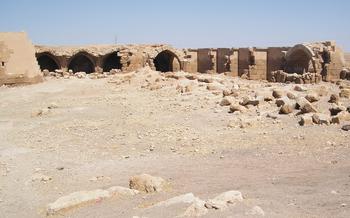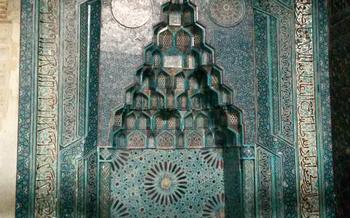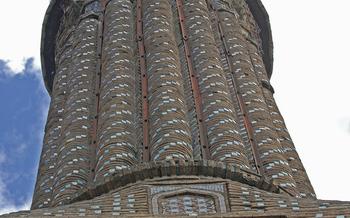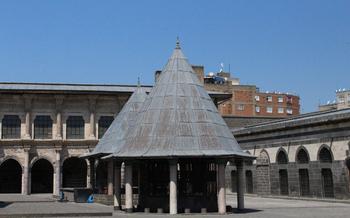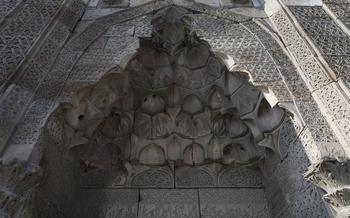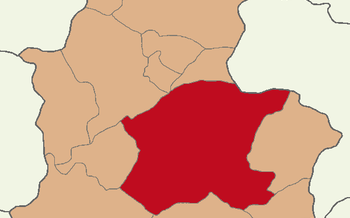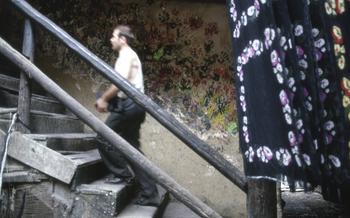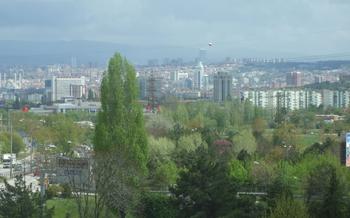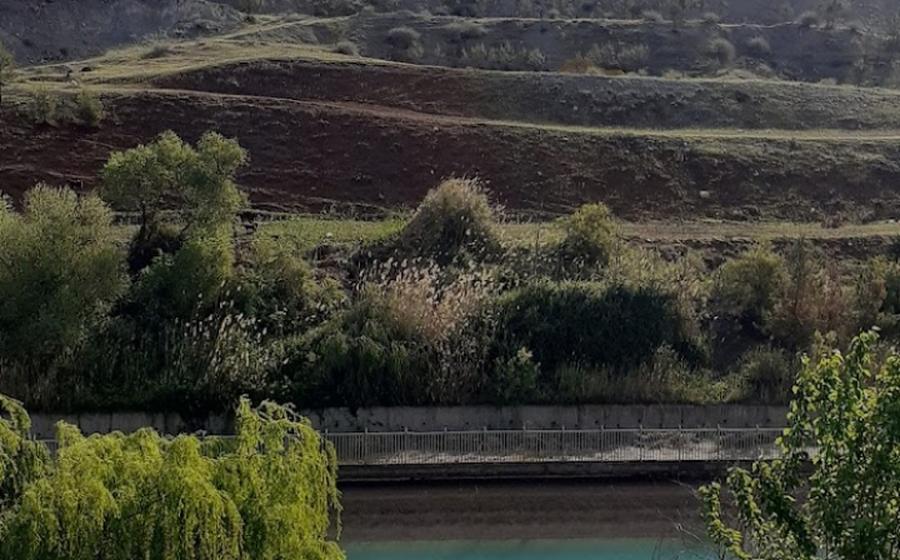
Kasimiye Medrese
- Architectural Marvel
- Stunning Tilework
- Educational Center
- Student Life
- Evolution Over Time
- UNESCO World Heritage Site
- Visiting the Kasimiye Medrese
- Suggested Itinerary
- Immersive Experience
- Local Handicrafts
- Customs and Traditions
- Photo Opportunities
- Off-the-Beaten-Path Gems
- Insider Tip: Experience the Cultural Vibrancy
Architectural Marvel
The Kasimiye Medrese stands as a testament to the architectural prowess of the Seljuk Sultanate. Its unique style blends elements of Islamic and Byzantine architecture, creating a harmonious and visually stunning masterpiece. Intricate stone carvings adorn the exterior, showcasing scenes from the Quran and geometric patterns that seem to dance across the facade. The grand entrance gateway, with its towering arch and ornate decorations, invites visitors into a world of learning and spirituality.
Stepping through the gateway, one enters a serene inner courtyard, surrounded by arcaded hallways and domed chambers. The courtyard provides a tranquil respite from the bustling city outside, offering a space for contemplation and reflection. The harmonious arrangement of arches, columns, and domes creates a sense of balance and order, showcasing the architectural mastery of the Seljuk builders.
Stunning Tilework
The Kasimiye Medrese is renowned for its exquisite ceramic tiles that adorn the interior, creating a mesmerizing visual display. These tiles showcase vibrant colors and intricate geometric patterns, each meticulously crafted by skilled artisans. The art of tile-making holds significant cultural importance in Turkey, and the medrese's tiles are a testament to the country's rich artistic heritage.
Beyond their aesthetic appeal, these tiles also carry symbolic meanings and tell captivating stories. Many depict scenes from Islamic history and mythology, serving as a visual narrative for visitors to explore. The intricate patterns and motifs often hold deeper meanings, representing religious concepts, natural elements, or abstract ideas.
The tilework at the Kasimiye Medrese is not merely decorative; it serves as a powerful storytelling medium. Each tile contributes to a larger narrative, inviting visitors to delve into the rich history and culture of the region. The intricate designs, vibrant colors, and symbolic meanings of the tiles make the medrese a true masterpiece of Islamic art and architecture.
Educational Center
The primary function of the Kasimiye Medrese was to serve as a renowned educational institution, fostering Islamic scholarship and knowledge. It consisted of several designated areas for teaching and learning, including classrooms, lecture halls, and libraries. Here, students from various backgrounds gathered to study a comprehensive curriculum that encompassed Islamic law, theology, philosophy, literature, science, and more.
Among the most renowned scholars associated with the medrese was the prominent theologian and philosopher, Ibn Taymiyyah. His teachings attracted students from across the Islamic world, who sought to learn from his vast knowledge and insights. Other notable scholars included the jurist Abu Zakariyya al-Nawawi, the historian Ibn Kathir, and the physician Ibn al-Nafis. These erudite individuals contributed significantly to the development of Islamic thought and scholarship, leaving an indelible mark on the intellectual landscape of the region.
The medrese's educational impact extended beyond the classroom, as it also provided students with a nurturing environment for personal growth and development. Through interactions with teachers and fellow students, they formed strong bonds of friendship and camaraderie that often lasted a lifetime. Moreover, the medrese offered opportunities for students to participate in extracurricular activities such as debates, poetry recitals, and manuscript copying, fostering a well-rounded education that nurtured both their intellectual and social capacities.
Student Life
The Kasimiye Medrese, beyond its architectural and historical significance, also offers a glimpse into the daily lives of the students who once called it home. These young scholars lived within the medrese's walls, forming a close-knit community that fostered learning and spiritual growth.
Their days began at dawn, with prayers and ablutions, followed by attending lectures and discussions led by renowned scholars. The medrese's curriculum covered a wide range of subjects, including Islamic law, theology, philosophy, and sciences. Students engaged in lively debates and discussions, testing their knowledge and honing their critical thinking skills.
In between classes, students found moments of respite and relaxation within the medrese's tranquil courtyards. They strolled through the gardens, engaged in friendly conversations, or simply took some time to reflect and contemplate. These serene spaces provided a welcome contrast to the rigors of academic life.
Evenings were dedicated to individual study and contemplation. Students retreated to their modest rooms, furnished with simple cots and desks, to delve into books and manuscripts. The medrese's atmosphere encouraged a sense of discipline and dedication, nurturing a thirst for knowledge and spiritual development.
The students at the Kasimiye Medrese formed a close-knit community, bound by their shared pursuit of knowledge and faith. They supported and encouraged each other, creating a sense of camaraderie that extended beyond the walls of the medrese. Through their interactions and shared experiences, they forged lifelong bonds that shaped their future paths as scholars and individuals.
Evolution Over Time
The Kasimiye Medrese has undergone various transformations throughout history, adapting to changing circumstances and needs. In the 16th century, during the Ottoman period, it was converted into a caravanserai, a resting place for travelers and traders along the Silk Road. The medrese's vast courtyard and sturdy architecture made it an ideal location for weary travelers to seek shelter and refreshment.
During the 19th century, the Kasimiye Medrese faced a period of decline and neglect. However, in the 20th century, it underwent extensive restoration efforts, led by Turkish authorities and international organizations. These efforts aimed to preserve the medrese's architectural integrity and restore its former glory.
Today, the Kasimiye Medrese stands as a testament to its enduring legacy. It has been designated as a UNESCO World Heritage Site, recognizing its exceptional cultural and historical value. The medrese is now open to the public as a museum, allowing visitors to explore its intricate architecture, stunning tilework, and rich history.
UNESCO World Heritage Site
The Kasimiye Medrese's exceptional cultural and historical significance has been recognized by UNESCO, earning it a coveted spot on the World Heritage List. This designation is bestowed upon sites that exhibit outstanding universal value, highlighting their importance to humanity as a whole. The medrese meets multiple criteria for inclusion, including its unique architectural style, exquisite tilework, and its role as a renowned center of Islamic scholarship.
UNESCO's recognition serves as a testament to the enduring legacy of the Seljuk Sultanate and the enduring impact of the Kasimiye Medrese on Islamic education and culture. The designation also underscores the importance of preserving and protecting this remarkable site for future generations to appreciate and learn from. As a result, ongoing efforts are in place to safeguard and promote the medrese, ensuring its continued existence as a symbol of Turkey's rich cultural heritage.
Visiting the Kasimiye Medrese
Visiting the Kasimiye Medrese is an enriching and awe-inspiring experience that offers a glimpse into the region's rich history and architectural heritage. Situated in the heart of Şanlıurfa, the medrese is conveniently accessible by public transportation or taxi. Admission fees are nominal, and visiting hours are generally from 9 AM to 5 PM, although it's advisable to check for any seasonal variations. Guided tours are available for a deeper understanding of the site's significance, but self-exploration allows for a more intimate and personal experience.
Photography enthusiasts will delight in capturing the intricate details of the medrese's architecture and tilework. A wide-angle lens is recommended to capture the grandeur of the courtyards and gateways, while a macro lens will help showcase the exquisite carvings and tile patterns up close. Remember to be respectful of other visitors and avoid using flash photography to preserve the ambiance of the site.
Suggested Itinerary
For an optimal experience, plan your visit to the Kasimiye Medrese during the spring or fall, when the weather is pleasant and conducive to exploration. Combine your visit with other nearby attractions to create a well-rounded itinerary for exploring Şanlıurfa. Start your day at the medrese, immersing yourself in its history, architecture, and tilework. Afterwards, visit the nearby Şanlıurfa Museum to delve deeper into the region's rich cultural heritage. If time permits, explore the historic bazaars, where you can find unique handicrafts, souvenirs, and culinary delights. Allow at least half a day to fully appreciate the Kasimiye Medrese and its surroundings. This duration provides ample time to absorb the site's beauty, learn about its significance, and capture stunning photographs.
Immersive Experience
Visiting the Kasimiye Medrese is not just about appreciating its architectural and historical significance; it is also about immersing oneself in the vibrant local culture. Engage with the friendly locals, who are always eager to share their stories and traditions. Participate in hands-on activities and workshops to learn about traditional crafts, such as tile-making or calligraphy. Attend traditional performances and storytelling sessions to gain insights into the rich cultural heritage of the region. Indulge in culinary experiences by savoring local delicacies at nearby restaurants or trying your hand at cooking a traditional Turkish dish. Embrace the warmth and hospitality of the Turkish people, who are known for their welcoming nature. By immersing yourself in the local culture, you will create a truly memorable and enriching travel experience.
Local Handicrafts
Strolling through the vibrant local market situated near the Kasimiye Medrese is a delightful experience that offers visitors a glimpse into the region's rich craftsmanship. Here, you'll find an array of unique handmade souvenirs that showcase the talents of local artisans. From intricate jewelry and colorful carpets to hand-painted ceramics and traditional textiles, there's something for every taste and budget.
One of the highlights of the market is the opportunity to interact with the artisans themselves. They are often eager to share their stories and demonstrate their techniques, providing visitors with a deeper understanding of the creative process behind each piece. You can witness the intricate weaving of rugs, the delicate brushstrokes of pottery painting, and the skillful hands crafting jewelry from precious metals.
Supporting local artisans by purchasing their products not only contributes to the preservation of traditional crafts but also helps sustain the livelihoods of these talented individuals. Bargaining is a common practice in Turkish markets, and engaging in this friendly exchange is a great way to connect with locals and score unique pieces at a fair price. Remember to approach the process with respect and a genuine interest in the artisan's work.
Exploring the local market is a wonderful way to take home a piece of Şanlıurfa's culture and craftsmanship. Whether you're looking for a special gift, a memento of your travels, or simply a beautiful object to decorate your home, you're sure to find something truly special amidst the vibrant stalls of this bustling marketplace.
Customs and Traditions
When visiting the Kasimiye Medrese, it is important to be mindful of local customs and traditions to ensure a respectful and immersive experience. One significant aspect of Turkish culture is hospitality, and visitors are often welcomed with warmth and generosity. A simple greeting of "Merhaba" (hello) accompanied by a smile can go a long way in fostering positive interactions.
Dressing modestly is recommended, especially for women, as a sign of respect for religious beliefs and practices. Covering shoulders and knees is generally considered appropriate attire when visiting religious or historical sites. It is also important to be respectful of the local religious beliefs and practices. Visitors should avoid making loud noises or engaging in disruptive behavior within the medrese, as it is considered a sacred space.
Interacting with locals is an excellent way to learn more about the customs and traditions of Şanlıurfa. Engaging in conversations with shopkeepers, artisans, or fellow travelers can provide valuable insights into the local culture. However, it is essential to be respectful of personal space and boundaries, especially when taking photographs or asking questions.
By understanding and respecting local customs and traditions, visitors can create a meaningful and enriching experience at the Kasimiye Medrese and contribute to the preservation of its cultural heritage.
Photo Opportunities
The Kasimiye Medrese presents a treasure trove of photo opportunities for visitors with a keen eye for aesthetics. To capture the essence of this architectural marvel, focus on highlighting the intricate details of the stone carvings, calligraphy, and tilework. The grand entrance gateway, with its imposing arch and decorative embellishments, serves as a striking focal point. Step into the inner courtyard and let the serene atmosphere envelop you as you photograph the surrounding iwans, each adorned with unique tile patterns. Don't miss the opportunity to capture the interplay of light and shadow as the sun casts a warm glow on the medrese's surfaces. Even with limited equipment, you can create stunning photographs by experimenting with different angles and perspectives. Share your experiences and showcase the beauty of this hidden gem through social media, inspiring others to embark on their own journey of discovery.
Off-the-Beaten-Path Gems
While the Kasimiye Medrese is undoubtedly a must-visit attraction in Şanlıurfa, there are also a number of lesser-known gems in the vicinity that are waiting to be discovered. For those seeking an off-the-beaten-path experience, here are some suggestions:
-
Bazar of Colours: Located just a short walk from the medrese, this vibrant market is a treasure trove of handmade crafts, textiles, and souvenirs. Lose yourself in the maze-like alleys, bargain with the friendly vendors, and find unique pieces to take home as mementos of your trip.
-
Halfeti: A picturesque town situated on the banks of the Euphrates River, Halfeti is known for its stunning black roses, which bloom in the spring. Take a boat tour to admire the roses up close, visit the historic castle, and savor the local cuisine, including the famous pistachio kebabs.
-
Gobekli Tepe: Considered one of the world's oldest temples, Gobekli Tepe is a fascinating archaeological site located about an hour's drive from Şanlıurfa. Explore the mysterious stone circles and megaliths, and learn about the advanced civilization that built them over 10,000 years ago.
-
Karakoyun: This ancient village is home to a remarkable collection of rock-cut tombs dating back to the Roman period. Wander among the tombs, marvel at the intricate carvings, and soak in the tranquil atmosphere of this hidden gem.
Venturing beyond the main tourist attractions allows you to experience the true essence of Şanlıurfa and gain a deeper understanding of its rich history and culture. Whether you're interested in shopping, nature, archaeology, or history, there's something for everyone to discover off the beaten path.
Insider Tip: Experience the Cultural Vibrancy
To fully immerse yourself in the cultural heritage of Şanlıurfa, make sure to attend one of the many cultural events or festivals held at the Kasimiye Medrese. These special occasions bring the site to life with vibrant performances, traditional music, storytelling, and demonstrations of local crafts.
Immerse yourself in the captivating atmosphere as you witness whirling dervishes perform their mesmerizing dance, or listen to the soulful melodies of traditional Turkish music. Learn about the art of tile-making through interactive workshops, where you can create your own tile inspired by the medrese's exquisite craftsmanship.
Indulge in the local cuisine by sampling traditional delicacies prepared by local women, and savor the flavors of Şanlıurfa's rich culinary heritage. These events offer a unique opportunity to engage with the local community and gain a deeper understanding of Turkish customs and traditions.
Attending a cultural event at the Kasimiye Medrese will make your visit even more immersive and unforgettable, leaving you with lasting memories of the vibrant cultural heritage that this historic site represents.
